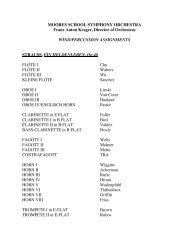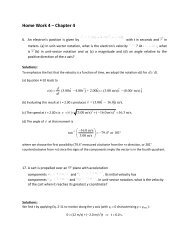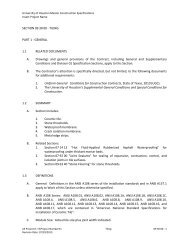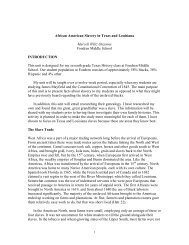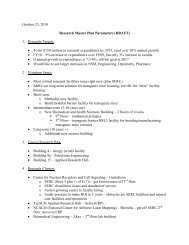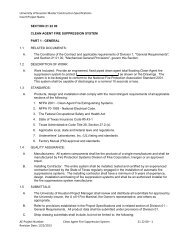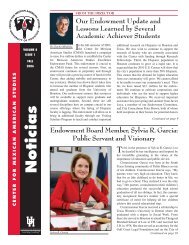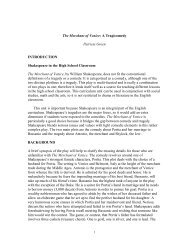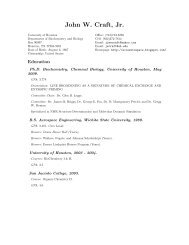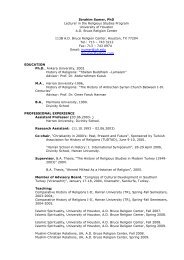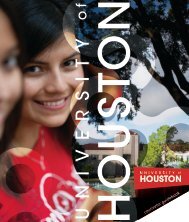Going Green: Biomimicry Francisca Eunice Gomez Rebullida ...
Going Green: Biomimicry Francisca Eunice Gomez Rebullida ...
Going Green: Biomimicry Francisca Eunice Gomez Rebullida ...
You also want an ePaper? Increase the reach of your titles
YUMPU automatically turns print PDFs into web optimized ePapers that Google loves.
INTRODUCTION<br />
<strong>Going</strong> <strong>Green</strong>: <strong>Biomimicry</strong><br />
<strong>Francisca</strong> <strong>Eunice</strong> <strong>Gomez</strong> <strong>Rebullida</strong><br />
Tinsley Elementary School<br />
Imagine the world without the Sun. It would be dark, cold, and lifeless. No living thing would<br />
ever exist. However, the Sun is for me the giver of life on the planet Earth. It is one of the<br />
brightest stars closest to Earth and the center of our solar system, giving us heat, light, and solar<br />
energy. Electromagnetic radiation is the energy that reaches the Earth from the Sun. This energy<br />
makes plants grow so that all living things exist, and since sunlight is pure energy, green plants<br />
use the Sun’s energy to make food. The plant could capture directly its energy. As I look out my<br />
kitchen window, I am amazed to see how a lima bean seed has grown into a bean plant. The Sun<br />
is the only source of energy in our world that could make this tiny seed grow into a plant.<br />
Although I cannot see the valuable process of photosynthesis as it takes place every time the Sun<br />
rises, I know that it is indeed happening.<br />
My curriculum unit will emphasize one of nature’s principles: Nature runs on sunlight.<br />
Janine Benyus is one of the researchers who discovered that biomimics are discovering that<br />
nature works in peoples’ lives. According to Benyus, biomimicry translates to bio as life and<br />
mimesis to imitate. <strong>Biomimicry</strong> is a new science that studies nature’s best ideas and imitates it to<br />
solve human problems. It is the study of how nature could be the primary source of solutions to<br />
our problems. Its overriding premise suggests the study of nature’s best ideas, then an imitation<br />
of them to solve human problems. Therefore, Benyus believes that life is based on simple<br />
principles.<br />
At Tinsley Elementary School, the core content areas such as reading, math and science are<br />
departmentalized. There are six classes of 5 th graders. Each class has an average number of 24<br />
students. The students are divided into two groups, namely the boys and the girls. I teach science<br />
to the boys that are mostly English as a Second Language Learners (ESL) as well as native<br />
speakers of English. Krashen states that when schools provide quality education in their primary<br />
language, students learn two things: knowledge and literacy. The knowledge that the children<br />
learn through their first language allows the English they hear to become more comprehensible.<br />
Literacy developed in their first language transfers to the second language. My school has a<br />
traditional ESL program. There are bilingual classes from first to third grades and ESL classes<br />
from fourth to fifth grades.<br />
ESL instruction helps the language learners use more contextualized language in math and<br />
science. The ESL classes bridge the gap between instruction in the first language and instruction<br />
in the second language. The students become proficient in their second language. Aside from the<br />
being second language learners, there is high mobility in my school because most of the students<br />
live in apartment buildings. So the students are not only challenged to learn English in the<br />
academic areas but also have to deal with high mobility. The unit is designed to help second<br />
language learners learn science more effectively.<br />
<strong>Francisca</strong> <strong>Eunice</strong> <strong>Gomez</strong> <strong>Rebullida</strong> 69
I mentioned earlier that teaching science is also integrating reading/language arts using literature<br />
books. I use literature or trade books to teach my unit. I teach comprehension strategies in the<br />
content areas – for example, science. It makes learning the science concepts easier, allowing ESL<br />
learners to understand science vocabulary words and the different concepts presented. Because of<br />
the language skills involved in listening, speaking, reading and writing, learning science words is<br />
challenging for ESL learners.<br />
Jim Cummins makes a distinction between the Basic Interpersonal Skills (BICS) and the<br />
CALP (Cognitive Academic Language Proficiency) for second language learners. Conversational<br />
fluency is often required achieve to a functional level within two years of initial exposure to the<br />
second language, whereas at least five years is usually required to catch up to native speakers in<br />
initial aspects of the second language. Teachers have to take these two aspects into account;<br />
otherwise, ESL students who are mainstreamed in the regular classes will have difficulty in the<br />
content areas such as science and math. Second language learners need to be competent not only<br />
in their oral communication skills also in their reading and writing skills. Some of these students<br />
are also coming from different cultural environments. For these reasons, I am using the literature<br />
approach to teach the science concepts. My unit is designed to help the ESL learners understand<br />
the science concepts as well as succeed in the yearly state assessment, the Texas Assessment of<br />
Knowledge and Skills, which the students take in April in order to be promoted to middle school.<br />
Photosynthesis is one of the favorite science topics of my fifth graders. According to the<br />
Horizontal Alignment Curriculum of the Houston Independent School District, there are two<br />
objectives in teaching photosynthesis. First, the students should be able to describe and explain<br />
some interactions that occur in simple systems, such as with the Sun’s involvement in the water<br />
cycle, energy transfers in the food webs, or water particles in the freezing, melting, and boiling<br />
point of water. Lastly, they should be able to describe some cycles, structures, and processes that<br />
are found in the water cycle and in food webs. One of the objectives in our state curriculum is life<br />
science. Some of the topics covered were photosynthesis, food webs, life cycles, and natural<br />
resources. I chose the topic of biomimicry to teach in depth the process of photosynthesis which<br />
is all about the Sun’s energy giving life to all living things on Earth.<br />
One spring day, when the students had a simple experiment on plant growth, I observed the<br />
enthusiasm and the awe when they planted lima beans in plastic cups and observed their growth<br />
in four weeks. It is my desire that this unit will give them more knowledge of how the Sun’s<br />
energy helps green plants produce their own food and how they will be able to start their own<br />
vegetable gardens in the limited space that they have.<br />
RATIONALE<br />
<strong>Going</strong> <strong>Green</strong> is an interesting seminar. Rives Taylor explains that going green is being explored<br />
in different fields. The merging minds of architects, scientists, biologists, and educators are<br />
working together in the <strong>Biomimicry</strong> Revolution. They are trying to solve problems that involve<br />
nature, using the new approach of solving problems by doing them nature’s way and<br />
manufacturing the way the plants and animals do, like using the Sun and simple compounds to<br />
produce totally biodegradable fibers ceramics, plastics, and chemicals. According to Benyus,<br />
American farms are modeled on prairies, and to sustain the produce of these farms, it would be<br />
best to use self-fertilizing and natural pest resistance. <strong>Biomimicry</strong> seeks to find new drugs or<br />
crops, so that the biomimics can study animals and insects that have used plants for millions of<br />
years to keep themselves healthy and nourished. Now is the time to be conscious of making use<br />
of what nature teaches us to sustain the Earth.<br />
I learned from my seminar that there are a lot of changes happening in our environment. For<br />
example, global warming is on the rise. The ozone layer has depleted. Pollution ravages our soil,<br />
air, and water. I decided to teach this unit on biomimicry, particularly photosynthesis, because I<br />
70<br />
Houston Teachers Institute
elieve that students will have to understand that they are the future Earth keepers. They must<br />
start their awareness now of how to take care of the Earth. This awareness will bring about<br />
responsibility and the consciousness of the fact that it is their generation that will sustain life.<br />
<strong>Biomimicry</strong> creates conditions conducive to life. The three basic needs of man are food,<br />
clothing, and shelter. Food provides us energy. All living organisms need energy to survive.<br />
Consumers, like the animals, must eat food to get energy. Plants are producers and must make<br />
their own food. Sunlight is needed to provide plants with the energy to make their food.<br />
Photosynthesis is easy for the students to understand. They may not see the process of plants<br />
making their own food with their own eyes; however, when they see a seed grow over time, they<br />
will begin to understand photosynthesis. Our seminar discussions have led to the idea of creating<br />
a mini vegetable garden in a pot or in a backyard to provide students organic vegetables. Some of<br />
the students have limited spaces for gardens or do not have backyards; however, planting seeds<br />
even in containers will help provide food for their personal consumption. The students will also<br />
learn that nature takes its course for photosynthesis. Everything involved in the process of<br />
photosynthesis is natural. Sunlight provides light energy. Chlorophyll provides the green<br />
coloring of the plant. When combined with light, plants make sugar. Then the plants give off<br />
oxygen. Plants absorb carbon dioxide from the air, and that is this is what makes life sustainable.<br />
This curriculum unit is intended for fifth graders in ESL Science and could be modified for<br />
students in the mainstreamed classes or for those native English speakers.<br />
I am inspired by Janine Benyus, known as one of the biological science writers who has her<br />
heart set on the preservation of nature. She has written six books including the latest one entitled<br />
<strong>Biomimicry</strong>. This is a new idea for me, and in the <strong>Going</strong> <strong>Green</strong> seminar I learned so much from<br />
it. I learned a new way of looking at nature.<br />
Benyus states that biomimicry is a new science that studies models and then imitates or takes<br />
inspiration from these designs and processes to solve human problems. It uses ecological<br />
standards to judge the “rightness” of our innovations. She mentions that after 3.8 billion years of<br />
evolution, nature has learned what works, what is appropriate, and what lasts. Her powerful<br />
insight is strategizing a course correction for humans to save humans from humans as we<br />
systematically destroy our habitat. She strongly believes that we save what we love, we love<br />
what we understand, and we understand what we are taught. I know that 5 th graders will be<br />
interested to learn more about plants and photosynthesis. It is my desire that as my students move<br />
on to the middle school, they will learn to value the importance of plants in their lives. They will<br />
in their own little ways love nature. The closest organisms that I think they could relate to is<br />
plants.<br />
UNIT BACKGROUND<br />
Author Background – The Remarkable Janine Benyus<br />
I read several articles and watched a video of the nature activist, Janine Benyus. She has put the<br />
jargon biomimicry in the English language. She has brought people from different fields of life<br />
together to help save nature from being destroyed by humans. Her childhood was spent in the<br />
Garden State of New Jersey where she was surrounded by trees, a meadow filled with wild<br />
flowers, and a wooded ravine with a creek. When she was ten years old, progress set in. Her<br />
beautiful natural environment was plowed to make way for a new subdivision. The sight of huge<br />
pieces of equipment and orange flags changed her life forever. She wrote the book <strong>Biomimicry</strong>:<br />
Innovation Inspired by Nature. It is a book that inspires readers to read about the mysteries of the<br />
natural world.<br />
Benyus describes biomimics working at the edges of their discipline where ecology meets<br />
agriculture, medicine, materials science, energy, computing, and commerce who are learning<br />
<strong>Francisca</strong> <strong>Eunice</strong> <strong>Gomez</strong> <strong>Rebullida</strong> 71
there is more to discover than to invent. Photosynthesis is a miraculous process by which the Sun<br />
turns light into life. According to Benyus this is a phenomenal process whereby sunlight, carbon<br />
dioxide, and water are combined within us to produce waste products that plants then use to make<br />
sugar and water. This provides humans and animals with oxygen – thus, the circle of life. Benyus<br />
gives the nine basic laws of the circle of life, which is the basis of her work.<br />
Benyus states that light is life. It is gathering energy like a leaf. She describes the duckweed<br />
plant with a single round leaf, as thin as paper and no wider than a pencil eraser. The duckweed<br />
survives in the winter because it is at the bottom of the frozen pond feeding at its own starch. In<br />
May the duckweed multiplies very quickly and covers the pond. People driving by are amazed<br />
by its perfect green coloring. Most of them think that the pond is a wet green paint.<br />
She also mentions the experiment done in the 18 th century by Joseph Priestley, an English<br />
amateur scientist, who put a mouse on a sealed jar with a candle and observed that it died.<br />
However, he made another experiment using the same materials but adding a mint plant to the<br />
mix. The result he observed was that the mouse survived because vegetation somehow repaired<br />
the air.<br />
The nine laws of the circle of life are as follows: nature runs on sunlight, nature uses only the<br />
energy it needs, nature fits form to function, nature recycles everything, nature rewards<br />
cooperation, nature banks on diversity, nature demands local expertise, nature curbs excesses<br />
from within, and nature taps the power of limits. I will focus on the first law of the circle of life,<br />
which is that nature runs on sunlight. Plants are the main topic. In my curriculum unit I will use<br />
children’s literature books to teach the science concept. I mentioned earlier that the unit is<br />
designed for fifth graders who are second language speakers as well as for the students in the<br />
mainstreamed class. It will take about 10-15 days to teach this unit. The students will<br />
demonstrate an understanding that plants need the Sun, soil, water, and the seed of life. The<br />
process of photosynthesis makes Earth livable for millions of living organisms and provides the<br />
materials and energy that Earth’s creatures need to live and grow.<br />
As I create this curriculum unit, I try to make connections and reminisce on the good old days<br />
at my grandmother’s orchard. She owned a mango and coconut plantation. In my youth my dad<br />
made sure that my sisters and I spent the summer at my grandmother’s place. I remember how<br />
he, a businessman, spent time at her plantations quarterly and took care of those trees. Dad<br />
explained to me how the process of photosynthesis helped those mangoes and coconuts grow. At<br />
that time all I cared about was harvesting them, putting them in baskets, and seeing that the<br />
farmers picked them up and sold them at the market place. At times I remember seeing my<br />
grandmother’s house full of mangoes in the bedrooms with mangoes under our beds. I took notes<br />
as my grandmother told me how important it is to till the land and plant fruit trees.<br />
It is only after attending this seminar that the new information on biomimicry encouraged me<br />
to think back on land that is taken care of by the tenants and not by the owners. My ancestors<br />
were land owners and lived only on the produce of the land. However, during my generation, I<br />
have completely ignored it. The seminar leads me back to my awareness of land that was<br />
naturally fertilized which produced mangoes, coconuts, and rice abundantly. No chemicals and<br />
pesticides were used to fertilize the land. My interest in the land was rekindled.<br />
Also, I realized how my dad and grandmother took care of the land they had inherited from<br />
their great grandparents. I understand and appreciate how my sister retired from teaching and<br />
decided to take care of what my dad left behind. It is my hope that this unit will impact my<br />
students’ appreciation for trees and their awareness that planting trees or just simply planting<br />
vegetables will help them with growing their own food and sustaining them in small quantities. I<br />
would like my unit to at least make my students aware of how important nature is. For instance,<br />
72<br />
Houston Teachers Institute
the Sun is the major source of energy for the plants. Photosynthesis is nature’s system of<br />
allowing producers to grow their food so that animals and humans will have something to eat.<br />
Author: Rachel Carson<br />
Another environmentalist, Rachel Carson, was a marine biologist and a nature writer. Her<br />
career as a writer started when she worked for the US Department of Fisheries. Carson wrote<br />
three books, namely The Sea around Us, The Edge of the Sea, and Under the Sea. These books<br />
were bestsellers because Carson wrote about ocean life, from the shores to the deep waters. In<br />
the 1950s Rachel Carson became involved with environmental research. She was concerned<br />
about pesticides and their effect on humans and animals. In her research Carson found evidence<br />
of the pesticide cancer connection. In addition she did research on many individuals’ illnesses<br />
due to the use of the pesticide. For this reason, Carson wrote another bestseller, Silent Spring, in<br />
1962. It was a very powerful book. The title suggested her concern for the deteriorating natural<br />
world and the negative effects of pesticides on humans and animals. The level of environmental<br />
consciousness of pesticides greatly increased. Carson explains that the pesticides have a<br />
detrimental effect on the environment. This book was one of the reasons that DDT was banned in<br />
the United States. In spite of her bouts with cancer, Carson continued her vocal admonishments<br />
that in the future the use of pesticides would not simply target the pests but weaken the<br />
ecosystem. She maintained that the targeted pests would not be eradicated. Carson appeared in<br />
public to explain her environmental concerns. Finally in April 1964 she passed after fighting<br />
with breast cancer for her life. She bequeathed her writings, papers, and manuscript to Yale<br />
University and has inspired many people to nurture and protect our natural environment. One of<br />
them is Janine Benyus.<br />
Plants<br />
Plants come in all different shapes and sizes, but they all have the same parts – namely,<br />
roots, leaves, and stems. Plants can also have flowers, seeds, and fruits or nuts. Plants are<br />
important to all people and animals because we need food to stay alive. Plants are producers<br />
because they can make their own food through the process of photosynthesis. People and animals<br />
are the consumers. They need to get energy from the plants. Plants are important to humans<br />
because they provide aesthetic value, medicine, food, goods, recreation, air quality, water control,<br />
and erosion control, as well as having an impact on our climate, fish and wildlife habitats, and the<br />
ecosystem. Plants make our surroundings beautiful. Imagine the beautiful bluebonnets, flowers<br />
native to Texas that grow abundantly during spring. We see them growing wild on the sides of<br />
the streets, parks, and vacant land. They need to be exposed to the Sun directly for eight to ten<br />
hours to thrive well. These beautiful blue bonnets are the pride of Texas.<br />
Medicinal plants such as chinaberry or china tree, cypress, juniper, live oak, mistletoe, Osage,<br />
pecan, vitex, and yaupon are native to Texas. The chinaberries have yellow flowers and yellow<br />
poisonous fruit. Their toxicity depends on tree varieties. Native Americans used the plant<br />
externally to treat ringworms and tetterworms. The Cherokees used the leaves to repel insects<br />
from shelters and homes. The chinaberry fruit was dried and made into ceremonial beads. Native<br />
Americans believed that the fruits brought them good fortune. The bark was used as poison to<br />
fish. When eaten, the fish were stunned and easily captured (“Chinaberry”).<br />
The bald cypress trees are also found in Texas. Their bark is used to make cordage. Native<br />
Americans also used the bark as fire starters. The bald cypress trees grow in wetlands and are<br />
known as disease free trees. Florida cranes eat the seeds of the bald cypress. Other animals like<br />
deer and rabbits eat the young sapling. The bark is eaten by nutria (a large rodent with webbed<br />
feet) and other rodents. The root trees are made into furniture like table tops and house décor<br />
(“Cypress”).<br />
<strong>Francisca</strong> <strong>Eunice</strong> <strong>Gomez</strong> <strong>Rebullida</strong> 73
Juniper is an edible and medicinal plant. Juniper berries are used as spice. One must be<br />
careful not to eat too many berries because they can be toxic. The fruit is a spice for cooking<br />
stew, meat and barbecue sauce (that’s why there are many barbecue places in Texas which people<br />
can go to for delicious barbecue and barbecue sauce) (“Juniper.”).<br />
The white oak has two edible varieties, acorns and Burk oak acorns. These varieties are<br />
usually at their best when blended with water and then strained. Oak trees with rounded leaves<br />
are used for making acorn bread. The leaves are blended with water and then strained to get the<br />
juice out. As a result the juice leaches away tannins, making nut meal sweeter. The pin oak bark<br />
is used for medicinal purposes. The juice is extracted from the bark of the tree for dysentery,<br />
edema of joints, and intestinal pain, and is used as an analgesic (“White Oak”).<br />
There are many other trees native to Texas; however, the last one that I will describe is the<br />
most common tree found in the area where I live. It is the pecan tree. The fruit of this tree is<br />
edible. Pecans are used in salads, waffles, pancakes, desserts, candies, ham and vegetables. On a<br />
good day one can see people harvesting the nuts. Indeed, the nuts are a good food sources for<br />
humans, squirrels, turkey, fox and deer. Pecan wood is used for making brooms, mops and<br />
garden tools. All the trees that I mentioned have green leaves, which are necessary for the<br />
process of photosynthesis.<br />
Photosynthesis<br />
Photosynthesis is the process of converting light energy to chemical energy and storing it in<br />
the bonds of sugar. This process occurs in plants and some algae. Plants need only light energy,<br />
carbon dioxide, and water to make sugar. The process of photosynthesis takes place in the<br />
chloroplasts, specially using chlorophyll, the green pigment involved in photosynthesis.<br />
Photosynthesis takes place only on the leaves. These parts are called the lower and upper<br />
epidermis, the mesophyll, the veins (vascular bundles), and the stomata. The epidermis protects<br />
the leaf. The stomata are microscopic holes that absorb carbon dioxide and release oxygen. The<br />
vein or the vascular bundle transports water and other nutrients to the plant parts. Photosynthesis<br />
takes place in the mesophyll that contains the chlorophyll. The chlorophyll appears green<br />
because it absorbs the Sun’s red and blue light whereas the green light is not absorbed.<br />
Therefore, when that light reaches our eyes, it appears green (Carter).<br />
Algae are ocean plants. They are found in the ocean water. Algae are not considered plants<br />
but they make their own food the same way green plants achieve photosynthesis. Sunlight is<br />
needed to make their food. As a result of photosynthesis they give off oxygen in the ocean water.<br />
The Earth is mostly covered with oceans, so our oceans are the best source of oxygen. According<br />
to Kalman, the algae are the “rain forests” of the oceans.<br />
The Sun’s Energy<br />
The Sun existed billions of years ago and has produced energy for the Earth. It is the star<br />
closest to Earth and the center of our solar system. Most of the Earth’s energy comes from the<br />
Sun. Plants get their energy from the Sun. Seasons are caused by the Sun and the Sun gives off<br />
heat to keep the Earth warm. Life exists because of the Sun. All living things need the Sun to live<br />
and grow. Energy is invisible but our existence depends on it. Since the Sun is the source of<br />
energy everything begins with it. <strong>Green</strong> plants make their own food through the process of<br />
photosynthesis. They turn the Sun’s energy into food. The Sun provides us with remarkable<br />
energy. We do not see what is happening in the Sun itself, those solar explosions, but it is a fact<br />
that the Sun’s energy supplies us all the energy we need. As a result of its energy, the green<br />
plants affect our lives and our lifestyles. Think about the food that we eat, from our salad to the<br />
hamburger. It is the product of green plants that turns sunlight into chemical energy. Consider the<br />
automobiles and the electronics that we use daily, our decorative lights. All get the Sun’s energy<br />
74<br />
Houston Teachers Institute
ecause of the green plants that turned into fossil fuels which were the remains of the plants and<br />
animals whose bodies grew with sunlight.<br />
In addition, we know that the Sun is a huge ball of hot gases held together by gravity.<br />
Helium and hydrogen gases make up the Sun. The hydrogen gases move very quickly and collide<br />
with one another. When this happens they combine in order to make helium atoms. This process<br />
of combining atoms is called fusion. During this process there is a small amount of mass lost.<br />
The ratio of the hydrogen atom to a helium atom is almost two to one. The mass is transformed<br />
into an enormous amount of energy consisting of infrared and visible light. This is the reason<br />
why the light radiates in space, finally reaching the Earth. Although there is only a fraction of<br />
solar radiation that reaches us, the Sun is the source of almost all the energy on Earth.<br />
There is a television advertisement that shows the Sun as the giver of life. The Sun’s rays<br />
touch the flowers and plants and the environment changes into beautiful color scenery. Sunlight<br />
keeps on shining and turns the world into a beautiful, remarkable place! This is what<br />
environmentalists, scientists, architects, educators, and people like Janine Benyus and Rachel<br />
Carlson envision.<br />
This curriculum unit will be literature-based, and the second language learners will use books<br />
that will introduce the importance of the Sun and the concept of photosynthesis. Children’s<br />
literature will be taught to integrate reading and science. Research states that many leaders in the<br />
content areas of science, math, social studies, and reading agree that thematic learning is an<br />
effective tool to help children make connections in the content area. The children will be able to<br />
comprehend, expand their vocabulary skills, improve their language structure, and at the same<br />
time learn science concepts the fun way.<br />
The first children’s literature book that I will use for my fifth graders is The Environment,<br />
written by Michael Allaby. It is a book that explores science topics that the students will find<br />
interesting. It provides the readers information about the environment, climates and currents,<br />
plant life, the food web, and much more. Photosynthesis is explained clearly. It also shows a<br />
colorful, vivid image of a leaf and its photosynthesis.<br />
The famous Magic School Bus in the Rainforest, written by Joanna Cole and illustrated by<br />
Bruce Degen, will be the next book. This book relates the story of Ms. Frizzle and her science<br />
class taking a trip to the Rainforest in the magic school bus. She explains to them what a tropical<br />
forest is. There are different kinds of trees that make good homes for many animals as well as the<br />
gifts from the rainforest. These gifts make many of our favorite foods, such as chocolates and<br />
fruits. She tells the children that the rain forest plants are used to make natural products like skin<br />
lotion, herbal tea, and life-saving drugs. At the end of the story Ms. Frizzle and her class return<br />
to school. They discuss how the students can save the rain forest and find ways to stop its<br />
destruction before it is too late.<br />
After reading the Magic School Bus, students will compare and contrast plants that mimic<br />
medicine naturally in our forests. Some examples of these plants are Aspilia and Paradise<br />
Flower. The Aspilia is a bushy plant that self-medicates. Scientists have observed chimpanzees<br />
using these plants to medicate themselves. The effect is like natural antibiotics. The Paradise<br />
Flower tree is a plant that is used to prevent malaria. Desert Plants are plants that seek moisture<br />
from the soil. They contain water. The Balanites tree is used to cure infections and stop pains<br />
like stomach cramps. The Bog Dwarf plants are shrubs that can survive and pollinate our peat<br />
lands.<br />
I would like to mention that plants mimic nature as medicine. In the state of Texas there are<br />
plants that thrive for medicinal purpose. One of these herbs is the American licorice. It is a<br />
perennial member of the pea family which can grow to 3 feet tall. This plant is use to treat<br />
<strong>Francisca</strong> <strong>Eunice</strong> <strong>Gomez</strong> <strong>Rebullida</strong> 75
various ailments. The camphor weed is a biennial plant found in the roadside, in pastures, in<br />
prairies and overgrown fields. It’s found all over the place in spring and summer time. When<br />
picked or stepped on this plant smells like camphor oil (Cross). Is this the same flower that my<br />
grandmother crushed to treat my tummy aches?<br />
The third children’s literature book will be The Tree in the Ancient Forest, written by Carol<br />
Reed-Jones and illustrated by Christopher Canyon. The book begins with Aristotle’s famous<br />
quotation, “in all of nature there is something of the wonderful.” This book is all about how<br />
every animal and plant is important in nature. Both plants and animals depend on one another to<br />
survive. This is called interdependence. In the ancient forest is a tree. The story gives the details<br />
of how the tree gets its food from the soil and the animals that depend on it. The characters<br />
described in the ancient forest are described scientifically. The author explains, too, why ancient<br />
forests are important.<br />
The Forests, written by Joshua Rutten, is an interesting book that students will enjoy. The<br />
book describes what the forests look like, where they are located, and why forests are important<br />
to us. The pictures are beautiful. The interdependence of plants and animals is shown in this<br />
book. Also, it emphasizes how important the forests are to us. I will design a lesson plan for each<br />
story integrating science and reading. They will include listening, speaking, reading, and writing<br />
skills for the second language learners.<br />
For the science content area I will start with vocabulary words found in photosynthesis –<br />
namely, sunlight, hydrogen, carbon dioxide, chlorophyll, sugar, and oxygen. I will explain the<br />
importance of sunlight to plants, that living organisms need energy to survive, and the process of<br />
photosynthesis. I will also mention the origin of the word photosynthesis. In Greek, the word<br />
means “putting together by light.” Lastly, students will learn that after the Sun’s energy is<br />
trapped in the sugar and breaks apart, sugar gives out energy that the plant uses. This process is<br />
known as respiration.<br />
CONCLUSION<br />
This curriculum unit is designed for second language learners and could be modified for students<br />
in the mainstreamed classes in the fourth or fifth grade. <strong>Biomimicry</strong> is using the Earth’s<br />
resources wisely to sustain our only living planet. The students will learn that the Sun is the<br />
source of life on Earth. The energy is transferred to us when plants go through the process of<br />
photosynthesis. When green plants make their own food, they store the food and give us not only<br />
our food but also oxygen. People in turn give off carbon dioxide to the plants. The cycle<br />
continues and so does life. The unit leads to other science topics like the plant cycle, the carbonoxygen<br />
cycle, food webs, food chains, animal life cycles, habitats, global warming, ecosystems,<br />
and many more life science topics. The use of literature to teach this unit is important for second<br />
language learners because they will learn the science content and vocabulary words that will<br />
enable them to understand scientific concepts. This unit is part of the state curriculum. At the<br />
end of the fifth grade students are expected to understand the objectives and take the science state<br />
test to meet the promotion standards.<br />
LESSON PLANS<br />
Lesson Plan One: The Environment<br />
Objectives<br />
The student will describe how living organisms modify their physical environment to meet their<br />
needs; student will identify patterns of change, such as in weather, metamorphosis, and objects in<br />
the sky.<br />
76<br />
Houston Teachers Institute
Material and Resources<br />
Create a PowerPoint presentation of the environment presenting the important topics for<br />
discussion. Provide students materials to create their own project showing an environment of their<br />
choice. Provide a copy of Michael Allaby’s The Environment. Provide computer access for the<br />
students. Prepare the vocabulary words and matching pictures to go with it.<br />
Procedures and Activities<br />
Divide the class into five groups. There are four students (second language learners with advance<br />
high students) in each group. Show the PowerPoint and engage the students in a discussion<br />
among themselves. Assign a speaker for each group to share their discussion. Teacher records<br />
students’ responses on chart paper. Introduce the key vocabulary words, such as environment,<br />
living organisms, Earth, core, atmosphere, and ozone layer. Ask volunteers to match the pictures<br />
with the key words. Brainstorm with the students on what they know about the Environment.<br />
Write their responses on a K-W-L (what do you Know; what do you Want to know; what did you<br />
Learn?) chart. Begin the lesson asking the students what they think the book is all about.<br />
Describe the cover page. Each group will give their response. Read with the class the<br />
environment, climates, and currents, plant life, etc. Provide teacher information and check for<br />
understanding (comprehension questions). Explain the reading and science connection to the<br />
students. The second reading will focus on the science concepts, such as environment; how the<br />
Sun, air, and water affect climate; weather and the different vegetation that grows in an<br />
environment; and how plants make their own food (photosynthesis) and its byproduct (oxygen).<br />
After the whole class session, assign a particular topic to a group and ask them to write a<br />
group summary of the science concept learned after reading the story. Students will write their<br />
responses in Science Journals. The next activity is role-playing. Ask each student to choose an<br />
object or a living organism. One student could role-play as Sun. He/she will explain to the class<br />
how Sun affects weather/ climate. Another student could be Leaf. He/she will explain how Leaf<br />
makes food (photosynthesis). Teachers provide “hats” for the students to use during role playing.<br />
For homework, assign students the task of creating a postcard of their environment and write<br />
good sentences to describe it. The postcard will be mailed to a friend or relative who lives in<br />
another place.<br />
Puzzle activity: Teachers will explain, for example, the nitrogen cycle. Give each group a<br />
puzzle of the different stages of the nitrogen cycle and let the students put the puzzle correctly.<br />
After that the students in groups of four will create a poster of the carbon-nitrogen cycle using the<br />
different stages. Allow three minutes for group presentation.<br />
Assessment<br />
Each student will create an environment of his or her choice in a foldable project. Create a rubric<br />
with the students. Then, choose two or three Texas Assessment of Knowledge and Skills (TAKS)<br />
related questions for the students to answer. Create a vocabulary foldable (teacher model) of the<br />
vocabulary words. Students will write the word, definition, give examples, draw the picture, and<br />
use the vocabulary word in a sentence. Create a teacher-made worksheet to test science concepts;<br />
for example, explain in your own words how plants make their own food; compare and contrast a<br />
food web from a food chain; illustrate and describe the lifecycle of a plant, lake, or animal.<br />
Lesson Plan Two: The Magic School Bus in the Rain Forest<br />
Objectives<br />
The students will be able to describe how living organisms modify their physical environment to<br />
meet their needs; identify patterns of change such as weather; and compare the adaptive<br />
characteristics of species that improve their ability to survive and reproduce in all ecosystems.<br />
<strong>Francisca</strong> <strong>Eunice</strong> <strong>Gomez</strong> <strong>Rebullida</strong> 77
Material and Resources<br />
Provide The Magic School Bus in the Rainforest by Joanna Cole for each group (5-6 copies) and a<br />
video. Use chart paper to record students’ responses for the KWL Chart. Each group is provided<br />
with art supplies, such as construction paper, markers, crayons, colored pencils, pencils, and<br />
sticky notes.<br />
Procedures and Activities<br />
Students work in groups of four. Brainstorm for background knowledge. Teachers ask students<br />
what comes to students’ minds when they see the words “Rain Forest.” Allow the group to Think<br />
Pair and Share. Tell the students to write the group’s response on the sticky notes. Display their<br />
responses on the KWL chart on the K column. Next, tell the students to think what they would<br />
like to learn about the rain forest. Students will Think Pair and Share. Remind the students to<br />
write their responses on the sticky notes and display them on the KWL chart on the L column.<br />
The last column, L, will be filled out at the end of the lesson. Teachers will have vocabulary<br />
words with pictures prepared for each group. Discuss the vocabulary words: tropical rain forest,<br />
cocoa trees, bromeliad; leaf litter, canopy, pods, pollinate, peccaries, et cetera. Pretend you are<br />
one of Ms. Frizzle’s students as teachers read the book aloud. Engage the students with guided<br />
questions: Do you know that chocolate comes from plants? Why is the rain forest important to<br />
plants and animals? What are the different products that come from plants? Teachers read aloud<br />
the story and explain the vocabulary words as she/he reads along. Students will continue to work<br />
in groups and answer comprehension questions posted on the board or written on worksheets<br />
(group work). The next reading of the story will be focused on the science concepts. Students<br />
will describe the environment in the rainforest, the plants’ and animals’ adaptation, and think of<br />
why people need to protect/save the rain forest.<br />
For homework students will reread the story at home. Explain to them that they will be<br />
reading the story as a junior scientist. They will write make a list of plants and animals in the<br />
story. The next day use students’ lists to research on a plant or animal of their choice using the<br />
websites for students’ use.<br />
Another suggested activity for a compare and contrast activity is to ask each student to think<br />
and write about a plant from the rainforest and a plant from their backyard or at home.<br />
Remember to use research paper for this activity.<br />
Show The Magic School Bus in the Rain Forest video to the students. Students will work in<br />
groups of four. Allow them to Think-Pair-Share. Each group will write ten science facts from<br />
the video on construction paper. Display student work on classroom walls or the board. Each<br />
group will walk and view the different responses. Discuss with the whole class and have teachers<br />
clarify or explain the science concepts.<br />
Assessment<br />
Teachers will be able to assess the students as they participate in the whole class or group<br />
discussions. Students will create a poster of their favorite plant or animal in a rainforest habitat.<br />
Each group will present excerpts from the Rain Forest book. Students will create a rubric to<br />
grade their presentation (with teacher guidance). Create a class bulletin board that shows<br />
different pictures explaining the importance of the rain forest. Create a foldable (teacher model)<br />
that shows how people need plants for food and medicine. Students will include a description of<br />
each picture (allow the students to use the computer to research on this topic.<br />
78<br />
Houston Teachers Institute
Lesson Plan Three: The Tree in the Ancient Forest<br />
Objectives<br />
The students will be able to understand interdependence of plants and animals in the forest and<br />
describe the nitrogen cycle.<br />
Material and Resources<br />
Provide The Tree in the Ancient Forest resource book to each student or each pair of students.<br />
Use a Chart paper to display student’s work and the KWL chart. Prepare art supplies such as<br />
construction paper, colored paper, scissors, colored markers, pencils, and sticky notes. Distribute<br />
for each group a copy of nitrogen cycle pictures with sentence strips describing each stage.<br />
Display a nitrogen cycle poster for the class with arrows to use for the activity. Allow students to<br />
use the computers for Internet-appropriate research. Science journals will be used to write<br />
students’ thoughts/insights of what they learned after each lesson. Display a teacher-made farm<br />
model. Provide a yellow marker to highlight important information.<br />
Procedures and Activities<br />
Brainstorm students’ prior knowledge of an ancient forest. Write all responses on the KWL<br />
chart. Discuss briefly with the class their responses. Tell the students that the teacher will read<br />
aloud the selection. Teachers set the purpose of reading: if you were the ancient tree in the forest<br />
what information in the story would be important to you? Tell the students to use a yellow<br />
marker to highlight important information. Post the comprehension purpose on the classroom<br />
walls/overhead transparency/board. Teachers read the story aloud and pause for a vocabulary<br />
words that students do not understand and continue reading. After the read-aloud ask these<br />
questions: What did you highlight and why? Students will Think-Turn-Share what he/she<br />
thought was most important in the text. After a comprehension check make connections with the<br />
science content focus. Science vocabulary words will be taught using the vocabulary cards<br />
teacher tool. Provide a meaning of the science word and use student friendly explanations and<br />
visuals. Teach the nitrogen cycle and the carbon cycle. Teachers integrate the process in how the<br />
ancient tree has to get nutrients through the soil. Introduce the concept of nitrogen from the<br />
atmosphere that is converted into compounds that plants utilize as nutrients. To check for<br />
understanding teachers plan in advance for the comprehension purpose questions focusing on the<br />
science content area.<br />
Assessment<br />
Provide students with a large tree to model an ancient tree in the forest using the vocabulary<br />
words. Ask students to Think Pair and Share with their partners. Ask a volunteer from each<br />
group to write the names of the different parts of the tree; find the truffles; put the voles and mice<br />
that tunnel; put the owl that flies at night, that hunts the voles and mice; et cetera. Create a<br />
bulletin board that shows the importance of ancient forests. Teacher made handout of the<br />
nitrogen cycle on printed paper. Show the picture of the nitrogen cycle with the arrows on<br />
different stages and ask students to fill out the correct stage. The nitrogen cycle sentences are<br />
written on the top of the page for students to copy. Teachers model a farm. Explain how the<br />
farmers grow vegetables and take care of cows or sheep. (Show that plants provide food for the<br />
cows. Explain how the farmer gets oxygen from the air that plants give off. Provide the<br />
information that cows’ waste is broken down by bacteria/fungi and emit nitrogen). Students will<br />
write an information sheet that explains the nitrogen cycle. Teachers create a paper and pencil<br />
quiz to build up stamina.<br />
<strong>Francisca</strong> <strong>Eunice</strong> <strong>Gomez</strong> <strong>Rebullida</strong> 79
Lesson Plan Four: Forest<br />
Objectives<br />
The students will be able to observe and describe the habitats of organisms within an ecosystem,<br />
especially those located in northern parts of America; understand the variety of flora and fauna<br />
brought about by climate and environment; and observe and identify organisms with similar<br />
needs that compete with one another for resources such as oxygen, water, food, and space.<br />
Material and Resources<br />
Be sure to provide adequate copies of The Forest written by Joshua Rutten to students or each<br />
group of students. Use chart paper to make the KWL chart. Also, prepare a “parking lot” chart<br />
paper for those with questions written on sticky notes. Prepare art supplies such as construction<br />
paper, colored pencils, colored markers, and pencils.<br />
Science Journals to write student’s response/ thoughts about the topic. Video clips of<br />
different kinds of forests or a PowerPoint presentation of different kinds of forests; provide a<br />
world map to show different places of the forest in the United States or Canada (North America)<br />
and the other continents. Access to computers so that students can research using the websites<br />
provided by the school district for science. Library books for students to use as a research tool.<br />
Procedures and Activities<br />
Brainstorm for prior knowledge by asking them their thoughts about Forest. Students work in<br />
groups of four. Explain to them that they will Think Pair and Share with their partners. Each<br />
group will write their sentences on a sticky note and teachers will post their notes on the KWL<br />
chart displayed on the board. Then, tell the students to write down their thoughts on what would<br />
they like to know about the topic: forests. After working with their partners, they will write their<br />
responses on sticky notes to be displayed on the W part of the KWL chart. Teachers post the<br />
comprehension purpose questions on the overhead or classroom walls from the beginning to the<br />
end of the lesson. Teachers prepare in advance comprehension purpose questions (CPQ) for the<br />
first, second, and third reading. Read the CPQ questions to the students and remind them the<br />
purpose of their reading. Explain to students that they will be taking the role of junior forest<br />
rangers as they read along or read with the teacher. Introduce the text. Read the selection aloud<br />
to students; explain vocabulary words as teachers read along. Check for students’ understanding<br />
as teachers read for them. After the third reading integrate science concepts to the lesson. Teach<br />
the following vocabulary words: tree tops, giant green blanket, Sequoia, bristlecone pine, canopy,<br />
species, coniferous forest, rainforest, temperate forest, and nocturnal. Teachers will explain why<br />
trees lose their leaves, different animals that live in the forest, the importance of forests, forest<br />
locations, and why forests are in imminent danger.<br />
Whole class activity: Create a vocabulary foldable (Dinah Zikes) using construction paper.<br />
Students will write the word, give the definition, an example, use the word in a sentence and draw<br />
a picture to illustrate the word.<br />
Group activity: Locate a forest of your choice on the map. Use the computer to research<br />
information or facts. Create a poster to illustrate the forest. Be able to describe your forest.<br />
Students will come up with a Rubric. They will decide what are the criteria to get an A (4<br />
points), a B (3 points), a C (2 points) and a D (1 point). Each group will present students poster<br />
and explain their forest, what and how they came about their project. While group A presents, the<br />
other groups will make their evaluation.<br />
At the end of every lesson that I have prepared for the four lesson plans, teachers give time to<br />
recap what went well and what did not.<br />
80<br />
Houston Teachers Institute
Assessment<br />
Each student will create a diorama of their own forest. Use the students’ rubric and explain to the<br />
students that will be the grading system. Create a diorama. A diorama is a mini forest in a shoe<br />
box. Students will use their own art ideas like making tree models out of dried stems/branches, et<br />
cetera. Another form of assessment is the pyramid foldable. Students will compare and contrast<br />
different forests. The diorama or the foldable must have an explanation or an informational sheet<br />
written or typed up. Challenge the students to role-play trees in the forest telling others like<br />
humans and animals to save the trees because people and animals have destroyed their ecosystem<br />
and trees need help to sustain the Earth’s forests.<br />
ANNOTATED BIBLIOGRAPHY<br />
Works Cited<br />
Allaby, Michael. The Environment. .Milwaukee: Gareth Stevens Publishing. A World Almanac Education<br />
Company, 2000.<br />
The book describes the importance of a healthy environment and its effect to Earth’s survival.<br />
Benyus, Janine. <strong>Biomimicry</strong>: Innovation Inspired by Nature. New York: Harper Collins Publishers, 1988.<br />
This is a great book that explains the new science of biomimicry.<br />
Carson, Rachel. The Silent Spring. Boston, Houghton Mifflin, 1962.<br />
This book was written to describe the hazardous effects of DDT to human health and the environment.<br />
Carter, J. Stein. “Photosynthesis.” 2 Nov 2004. .<br />
This website provides the process of photosynthesis information.<br />
“Chinaberry, Chinatree.” Herbvideos.com. .<br />
This website provides information on chinaberries.<br />
Cole, Joanna. The Magic School Bus In The Rain Forest. New York, Scholastic Inc.,1998.<br />
Ms. Frizzle, the science teacher takes her students in her magic bus to the Amazon Forest.<br />
Cross, Jacqueline. “Ten Texas Native and Wild Plants” 28 Feb 2009. Dave’s Garden.<br />
.<br />
This website describes Texas plants that are medicinal.<br />
Cummings, Jim. ESL and Second Language Learning Web. 2003.<br />
.<br />
This website describes the BICS and CALP distinction by Jim Cummins.<br />
“Cypress.” Herbvideos.com. < http://www.herbvideos.com/cypress.htm>.<br />
“Juniper.” Herbvideos.com. .<br />
This website provides information on juniper trees.<br />
Kalman, Bobbie. Photosynthesis: Changing Sunlight into Food. New York: Crabtree Publishing Company,<br />
2005. This non-fiction science book describes photosynthesis.<br />
Krashen, Stephen. “Why Bilingual Education? ERIC Digest. .<br />
This website provides information about the importance of bilingual education by Stephen Krashen.<br />
Reed-Jones, Carol. The Tree in the Ancient Forest. Nevada, CA: Dawn Publications, 1995.<br />
This book will captivate students’ interest about animals depending on trees and trees depending on<br />
animals for survival.<br />
Rutten, Joshua. Forests..The Child’s World Incorporation, 1999.<br />
This book explains and shows beautiful illustrations of different forests.<br />
Taylor, Rives. Seminar Leader. “<strong>Going</strong> <strong>Green</strong>.” Houston Teacher’s Institute Seminar. Spring 2009.<br />
<strong>Francisca</strong> <strong>Eunice</strong> <strong>Gomez</strong> <strong>Rebullida</strong> 81
“White Oak.” Herbvideos.com. .<br />
This website provides oak trees information.<br />
Zikes, Dinah. .<br />
Dinah Might website provides you examples of foldable created by Dinah Zikes.<br />
SUPPLEMENTAL RESOURCES<br />
Beck, I.L., and M. G. McKeown. Improving Comprehension with Questioning the Author: A Fresh and<br />
Expanded View of a Powerful Approach. New York: Scholastic Inc., 2006.<br />
This book states how to create comprehension purpose questions for effective reading.<br />
Burns, Diane L. Berries Nuts and Seeds. Milwaukee: Gareth Stevens Publishing.<br />
This book identifies different varieties of berries, nuts and seeds.<br />
Burton, Jane and Taylor, Kim. The Nature and Science of Leaves. Gareth Stevens Publishing.<br />
Milwaukee, Wisconsin. This book describes the science in the natural world of leaves. It<br />
explains why leaves are a plant’s food factory, the carbon oxygen cycle and processes.<br />
Fowler, Allan. Energy from the Sun. Rookie Read About Series. Chicago: Children’s Press, 1998.<br />
This book defines the Sun’s energy and examines how energy provides us food, heat, light, and food to<br />
stay alive.<br />
Gust, Devens, and Thomas Moore. Mimicking Photosynthesis. Science (April 7, 1989): 35-41.<br />
This article explains how simple molecular dyads mimic photosynthesis.<br />
Lock, Deborah and Mack Lorrie. Forest: Open Your Eyes to a World of Discovery. New York: DK<br />
Publishing Incorporation, 2004.<br />
This book describes and introduces the different characteristics of forests found around the world, the<br />
plants and animals that populate them and how they are endangered.<br />
Macmillan, Dianne. Life in a Deciduous Forest. 2003. Learner Publications<br />
Company. Minneapolis, MN. This book describes the physical features, processes, and many<br />
different kinds of species of plants and animals that make up a unique deciduous forest ecosystem.<br />
Silverstein, Alvin and Virginia Silverstein, et al. Photosynthesis. Brookfield, CT: Twenty First Century<br />
Books, 1998. This book explains the process of photosynthesis.<br />
Websites<br />
.<br />
This website provides examples of good reading strategies.<br />
< http://www.nasa.gov/worldbook/Sun_worldbook.html>.<br />
This website provides information about the Sun.<br />
.<br />
This website by Discovery Education provides different lesson plans in science.<br />
.<br />
This is a fun website (teacher’s tool) for farm activities that kids would learn and enjoy.<br />
.<br />
This website is a sample high school lesson plan.<br />
.<br />
This website provides information about plants.<br />
.<br />
This website provides information about the blue bonnets.<br />
.<br />
This website provides information and images of pecan trees.<br />
82<br />
Houston Teachers Institute
.<br />
This website provides Rachel Carson’s biography.<br />
.<br />
This website provides more of Rachel Carson’s biography.<br />
.<br />
The website provides children information about photosynthesis.<br />
.<br />
This website provides information about the energy from the Sun.<br />
.<br />
This website provides more information about the Sun.<br />
.<br />
This website provides images of photosynthesis.<br />
< http://projectsol.aps.com/energy/energy_Sun.asp>.<br />
This website provides information about the Sun.<br />
ADDENDUM<br />
I would like to express my gratitude to our seminar leader, Rives Taylor, to Mary Ann Natunewicz, and to<br />
my family.<br />
<strong>Francisca</strong> <strong>Eunice</strong> <strong>Gomez</strong> <strong>Rebullida</strong> 83



